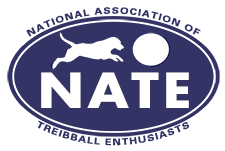Now that the dog understands the Push cue, the next step is to have the dog push a ball to you. This is started by having the dog facing the handler with the ball right between them. Ask the dog to push the ball into the handler’s legs & immediately reward as shown in the video below. Initially the handler is positioned very close to the dog and the ball so if the dog pushes the ball, it will hit the handler, which is the desired behavior.
Gradually increase the distance between the ball and yourself so the dog has to push the ball a little further to get its reward. As one increases the distance, one can make the dog more successful initially by setting up barriers to minimize the travel of the ball from errant pushes. Hallways or a barrier & a wall both work well for this early training.
Points to remember—
- Maintain the criteria of marking and rewarding for the ball hitting the handler.
- Reward on the dog side of the ball.
- Keep the distance short.
- If the ball veers off, you can help your dog by stepping in front of the path of the ball.
- The Push cue is the only word you need. Other words, even if meant to be encouraging and positive, are distracting.
When training the elements, not every send will end in a push, and not every push will start with a send. That means you’ll need to be able to leave your dog near the ball and walk to a point where you feel the dog can be successful in the push. Be careful not to let the act of backing up or walking away from a ball become the cue to push. If your dog starts pushing before you give the cue to push, cheerfully interrupt them and set up again. Reinforce the waiting at a closer distance. Back up, but then walk forward again and give them a treat from the other side of the ball. Mix it up so the dog knows the best path to success is waiting for your cue.
